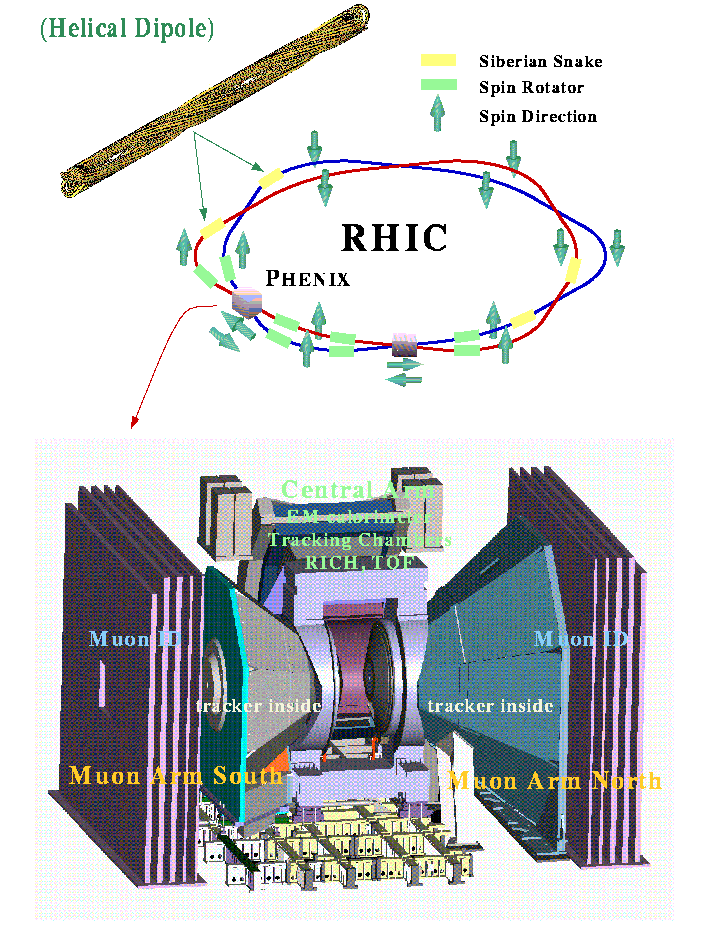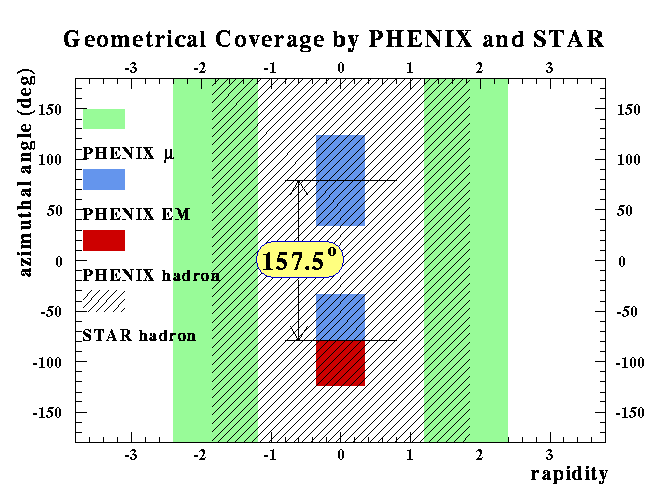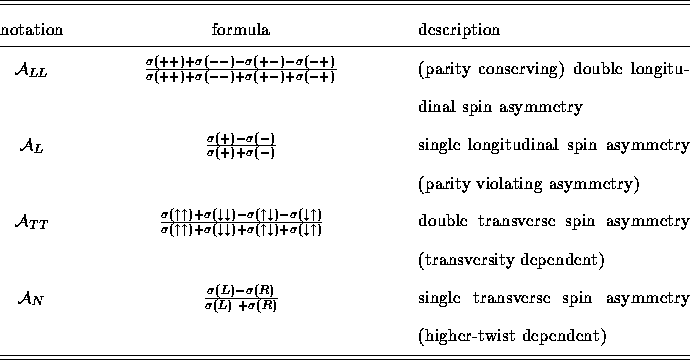 = 500 GeV and
its high luminosity of
2
= 500 GeV and
its high luminosity of
2 10
10 cm
cm sec
sec with high polarization of 70%.
Obviously we will confront energy frontier of the polarized proton-proton
collision
with high polarization of 70%.
Obviously we will confront energy frontier of the polarized proton-proton
collision .
The completion of the project is scheduled in the year of 2000.
.
The completion of the project is scheduled in the year of 2000.



The Relativistic Heavy Ion Collider (RHIC) is under construction at
Brookhaven National Laboratory (BNL). Primary purpose of RHIC is to
search for a new hadronic state, quark-gluon plasma (QGP).
In addition to the heavy ion physics program, the proposal to
explore spin physics at RHIC has been approved recently.
The major goals of the spin physics at RHIC are
the study of the spin structure
of the nucleon; the precision tests of the symmetries.
The RHIC offers a very unique opportunity for those studies
because of its capability of
accelerating polarized protons up to  = 500 GeV and
its high luminosity of
2
= 500 GeV and
its high luminosity of
2 10
10 cm
cm sec
sec with high polarization of 70%.
Obviously we will confront energy frontier of the polarized proton-proton
collision
with high polarization of 70%.
Obviously we will confront energy frontier of the polarized proton-proton
collision .
The completion of the project is scheduled in the year of 2000.
.
The completion of the project is scheduled in the year of 2000.
We, RIKEN, have started the project for spin physics studies since 1995 in collaboration with BNL. We are constructing Muon Arm for PHENIX as well as Siberian Snake, which maintains polarization in RHIC main rings. Both are essential to the spin physics at RHIC. Figure 1 shows two rings of RHIC, Siberian snakes, spin rotators, and PHENIX detector system. Arrows around two rings of the RHIC represent the polarization of the beam particles. The polarization of the beam particle will be maintained by Siberian snake magnets, which are helical dipole magnets. The spin of the beam particle can be rotated to the demanded direction before colliding points and the spin of the un-interacted beam particles will be rotated back to original direction by spin rotators which are to be located before and after the experimental halls. The particles produced in the reaction will be detected by two major detector systems, PHENIX and STAR.
The PHENIX detector system contains three parts; Central Arm and two Muon Arms. Central Arm consists of electromagnetic calorimeter, tracking chambers, ring-image cherenkov counters, and time-of-flight system. Both Muon Arms comprises three stations of tracking chambers and Muon Identifiers. The STAR detector system is based on time projection chamber and electromagnetic calorimeter. The geometrical acceptance of two detector systems are compared in Figure 2. The solid angle covered by PHENIX detector system is rather limited but the system is advantageous in identifying the particle species. The STAR detector system is more hermetic and advantageous in the detection of jet. In this sense, two detectors are complementary.
By use of the spin rotators, any combination of beam polarization is possible.
Thus we can measure the helicity dependent cross sections
 ,
,  ,
,  , and
, and  separately, where
+ and - represent positive and negative helicity states of the
beam particles
as well as transversity dependent cross sections,
separately, where
+ and - represent positive and negative helicity states of the
beam particles
as well as transversity dependent cross sections,
 ,
,  ,
,
 ,
,  ,
where
,
where  and
and  represent transverse polarization
of the beam particles.
represent transverse polarization
of the beam particles.

Figure: Two rings of RHIC, Siberian snakes, spin rotators,
and PHENIX detector system.
Here we define double longitudinal-spin asymmetry,  , as
, as

This asymmetry is often used to extract helicity dependent structure functions. A single longitudinal-spin asymmetry,

extracts parity violation effects in the reaction.
Similarly we can define double transverse-spin asymmetry  as
as

One more asymmetry which is often measured or predicted is the single transverse-spin asymmetry, or left right asymmetry;

which is the azimuthal asymmetry of a reaction .
.

Figure: Geometrical acceptance of PHENIX and STAR are
compared in the plane of rapidity versus azimuthal angle.

Table i: Notation, expression, and description for spin asymmetries.
The asymmetries are tabulated in Table i.
The asymmetry  can be non-zero even in parity
conserving process.
This asymmetry and
can be non-zero even in parity
conserving process.
This asymmetry and  are often used to probe helicity and transversity
structure of the nucleon, respectively.
The parity violating asymmetry is also used as a probe of the structure.
It is also sensitive to the symmetry/asymmetry in the interaction; e.g. contact
interaction of sub-quark structure might give a large parity violation as
described in Ref. [1].
The single transverse spin asymmetry
are often used to probe helicity and transversity
structure of the nucleon, respectively.
The parity violating asymmetry is also used as a probe of the structure.
It is also sensitive to the symmetry/asymmetry in the interaction; e.g. contact
interaction of sub-quark structure might give a large parity violation as
described in Ref. [1].
The single transverse spin asymmetry  has been measured
in fixed target energy and large asymmetry has been discovered e.g. in
pion productions at large
has been measured
in fixed target energy and large asymmetry has been discovered e.g. in
pion productions at large  [2].
In the perturbative QCD, the effect is
believed to originate
in higher-twist. Several non-perturbative models are also available
to explain measured asymmetries.
By measuring those asymmetries, the spin structure of the nucleon
will be elucidated and the symmetries lying in the nature will be
revealed.
[2].
In the perturbative QCD, the effect is
believed to originate
in higher-twist. Several non-perturbative models are also available
to explain measured asymmetries.
By measuring those asymmetries, the spin structure of the nucleon
will be elucidated and the symmetries lying in the nature will be
revealed.
In the rest of this paper, we will describe the physics issues which the RHIC spin project potentially covers focusing on the study of the spin structure of the nucleon. Summary follows in Section III.


